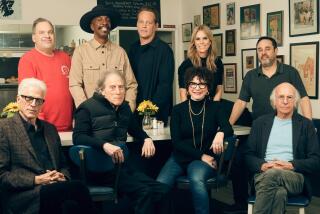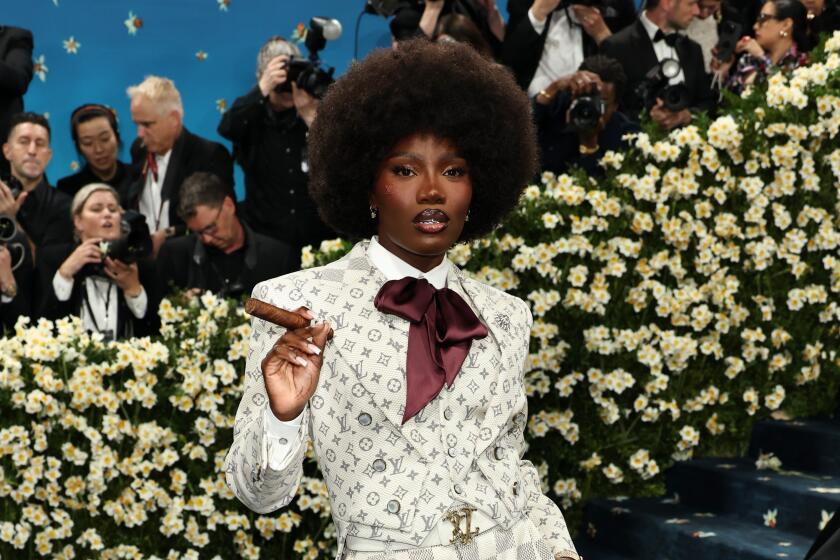Fandom’s Final Frontier: Homoerotic Literature
- Share via
Like so many things, it began with “Star Trek.” When Gene Roddenberry’s sci-fi adventure debuted to tepid reviews in 1966, no one had any inkling of the forces it would unleash. By dragging the world of sci-fi into the popular culture, the show created a whole new and wildly devoted fan base with an insatiable appetite for all things Trekkie.
Not content with just watching the show, fans began writing their own episodes, which they compiled and distributed in homemade “fanzines.” Given human nature, it was only a matter of time before certain fans began wondering what would happen if Capt. Kirk and Mr. Spock took their powerful friendship a step or two further. Highly romantic, detail-rich and usually pornographic, this sub-genre of plot lines began to boldly go where no scriptwriter had gone before.
To warn their more Puritan brethren, these writers, most of them women, would mark their homoerotic tales with the characters’ initials separated by a slash--K/S--and thus “slash” fiction was born. From “Star Trek,” slash spread to buddy-cop shows--”Starsky and Hutch” and “Emergency!” were among early favorites--and other sci-fi offerings. As copying became cheaper, fanzines, including those devoted to slash fiction, proliferated; Kinko’s remains the patron saint of fandom. But then along came the Internet and slash was never the same again.
Hundreds of slash sites litter the Internet, some with art, graphic and otherwise, most of them with archives full of stories. Hundreds of stories. Thousands of stories. Stories that describe cooings and couplings of the most extraordinary nature. Nothing is sacred, everything is slashed. Wonder what it would be like if Hawkeye and Trapper ever got together? Luke and Han Solo? Mulder and Skinner? The cast of “Homicide: Life on the Street?” Easy to find out, in novellas that range from the sweetly romantic to the eye-poppingly hard-core--most sites open with an explanation of what they are, inviting those who might be offended to “leave now.”
While there remains an obvious leaning to sci-fi and fantasy--lots of slash deals with characters from “Highlander,” “The Sentinel,” “The Pretender,” “Babylon 5” and even “Buffy the Vampire Slayer”--if it has fans, it has been slashed. “The Lord of the Rings” (Sam and Frodo, Pippin and Merry), “The A-Team,” “Sports Night,” “Ally McBeal,” “ER,” even “Harry Potter” (although these stories all carry an explanation that the characters are now in their late teens.)
At a slash convention attended by 150 people earlier this year in Santa Barbara, “West Wing” was the topic of one panel discussion. The two most likely couples? Sam Seaborn and Josh Lyman--already there are several very well-written stories dealing with their romance--and the president and Leo McGarry.
“Although you have to take into consideration that the president is married, and seems happily married, so you wouldn’t want to disrespect that,” says one longtime slash writer. “There are rules, after all.”
And there are rules. And conferences. And much introspection and dialogue between the growing legion of slash writers, who often spend six hours a day working on their hobby. There are even several scholars who now claim slash as an area of expertise.
Constance Penley, a professor in the department of film studies at UC Santa Barbara, has been studying slash for more than 20 years. Her 1997 book “NASA/Trek: Popular Science and Sex in America” (Verso) ends with several chapters on the phenomenon of slash. She stumbled across it while researching themes of gender in science fiction. As a feminist, she was drawn by the startling fact that most of this male-centered, homoerotic fiction is written by women. Straight women. Many of whom say that while they certainly enjoy the sexually explicit nature of the genre, they are more drawn to the emotional intensity of pairing two strong male characters.
“It’s a place for writing that is comfortable for women,” Penley says. “It’s not a big-time writing workshop, it can be done anonymously, there’s a support group aspect that makes it very attractive.”
There is a small but growing genre of lesbian slash--focused around such shows as “Xena: Warrior Princess,” and “ER,” but the vast majority of slash remains devoted to men. Many of the story lines are reminiscent of romance novels--forbidden love, with obstacles both external and internal--with a striking difference. The main characters are truly equal. And the fact that women must turn to gay male relationships to find this equality says much about the way women are portrayed on TV and in the movies.
“There are nowhere near the number of interesting women characters on television,” says one slash fan. “So if you want to get two powerful people together and see what happens, it has to be men.”
Other slash writers say that resolving the unresolved tensions is part of the appeal. “Two male characters may have an intimacy, a tension that is never really resolved,” says another woman who has been writing slash for 15 years. Female characters, she adds, get to resolve their intimacy issues in a variety of ways--women still touch and kiss and express their love for each other, albeit nonsexually, much more frequently than men do. “Picking up where the show left off, or left out, is the major appeal of slash for me.”
Every writer interviewed for this article requested anonymity--”we’re teachers and nannies, business owners and bosses,” says one. “We can’t afford people knowing about this particular obsession.” But understanding why they do what they do is almost as interesting to slash writers as doing it.
Essays defending or explaining the predilection appear on many of the Web sites--one lengthy discussion included quotes from “The Velveteen Rabbit” and footnotes, many of them from the work of Henry Jenkins, author of “Textual Poachers: Television Fans & Participatory Culture,” (Routledge, 1992) who has written about slash.
Not everyone struggles to find a deep inner meaning; for some it is simply proof that if men “like to watch,” women do too. With the explosion of Internet sites, the number of people who just watch, rather than write or otherwise participate, has grown exponentially. For some this is a disquieting change in the subculture.
“When I came in [to the slash community] everyone gave back,” says one writer. “If you couldn’t write, you collated. And the social network was stronger--you couldn’t find slash if you didn’t know someone. Now, you just go to [the search engine] Google and you can find hundreds of sites in two minutes.”
There was, she says, a huge resistance to the Internet fans at first--many slash conferences in the early ‘90s dealt with the differences between the zine and Net communities. Privacy, for instance, was a big issue among early slash fans--to “out” someone was the ultimate crime. And plagiarism of one slash writer by another was also a mortal sin. Both rules still stand, but ostracizing transgressors is almost impossible when identification, and communication, is all done electronically.
Although UCSB’s Penley says that the craftsmanship of slash writing is often remarkable, some writers feel it suffers online. “Of course 90% of anything is crap,” says one longtime writer. “But at least with zines there was some editing. Now people just type away and send; they don’t even spell check, much less get creative feedback. I know that some people are writing for the quick emotional thrill, and that’s fine. But we do try to do outreach. We tell them, if you take your time, work on your craft, you’ll get an even better thrill.”
For many slash writers, believability is the goal. The best scenarios capture the flavor and cadence of the show’s original writing. The obsession of fandom, many say, is the desire to inhabit the characters, to know more about them than the original creator. People outside of the subculture might argue that, by definition, slash is the ultimate act of disrespect, not to mention copyright infringement. Although slash writers argue that since they make no money for their work, no law is being broken, their desire for anonymity does rise, in part, from fear of prosecution by networks or studios.
“I am so afraid that as we get more attention, they’ll try to shut us down,” says one writer.
Thus far, slash zines and sites have been ignored by the original writers. Roddenberry, says Penley, knew all about it from the start and, she claims, there was a coy aside to slash fans in the final “Star Trek” movie--when Kirk and Spock are reunited toward the end of the film, Kirk makes a move to embrace his Vulcan friend, who, with a twitch of an eyebrow, says, “Please, Captain, not in front of the Klingons.”
“It’s a tribute,” says one woman, “that we love these characters so much.”
More to Read
The biggest entertainment stories
Get our big stories about Hollywood, film, television, music, arts, culture and more right in your inbox as soon as they publish.
You may occasionally receive promotional content from the Los Angeles Times.











